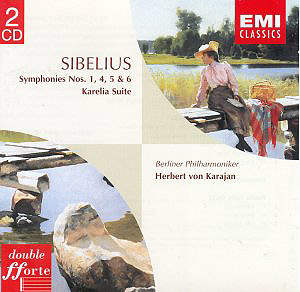Karajan was no mean Sibelian and his Fifth Symphony
was always worth a concentrated listen. I am by no means sympathetic
to the image builder he became (I still recall buying his 1977 DG Beethoven
symphonies box in which page after page was taken up with high definition
studio photos of our hero). However this is to jumble the man
with the music and the music, at least in Sibelius, is regal.
If his reading of the Fifth Symphony is best heard
in the DG 1965 version (part of a Panorama set) this one is also very
fine with majestic precision and no want of feeling or impulsive excitement.
His orchestra sounds like the top flight instrument it was and is. His
Fourth is broad and mysterious. It is a while since I heard the DG recording
from the 1960s but I seem to recall a faster pulse than he sustains
a decade or so later.
Karajan did not often dally with the First Symphony
- surprising really as it is the most Tchaikovskian of the seven and
Tchaikovsky was a favoured composer. This version is pretty broad and
I find myself feeling less engaged by the whole span though intermittently
strongly impressed for example by the work of the brass section. Turning
from Romantic excess (nothing wrong with that) to the cold passionate
essentials, I was moved by the Sixth Symphony. This, with the Third
(the latter a work mystifyingly a closed book to Karajan - did he ever
perform it - we know he never recorded the Third - why did he turn his
back on it?), has long been a favourite. Here it sparkles and glows
in the Nordic sun in a completely cherishable performance. A rocking
Sibelian ostinato is no mean thing and Karajan's feeling for structure
is always strong and communicative. The stereo byplay among the strings
is a sheer delight in the first movement (try tr 7 4.34)
One of these days I hope to renew acquaintance wih
Karajan's 1960s DG versions of symphonies 4-7.
If there is a downside with this set it is in the merest
hint of crowded tone in the louder sections but this is likely to impinge
only when listening on headphones.
I was intrigued to read that Karajan's association
with Sibelius went back at least as far his conductorship of the Aachen
orchestra in the 1930s. There he gave several performances of the Sixth
Symphony.
Multilingual scene setting notes by Stephen Johnson.
Rob Barnett


